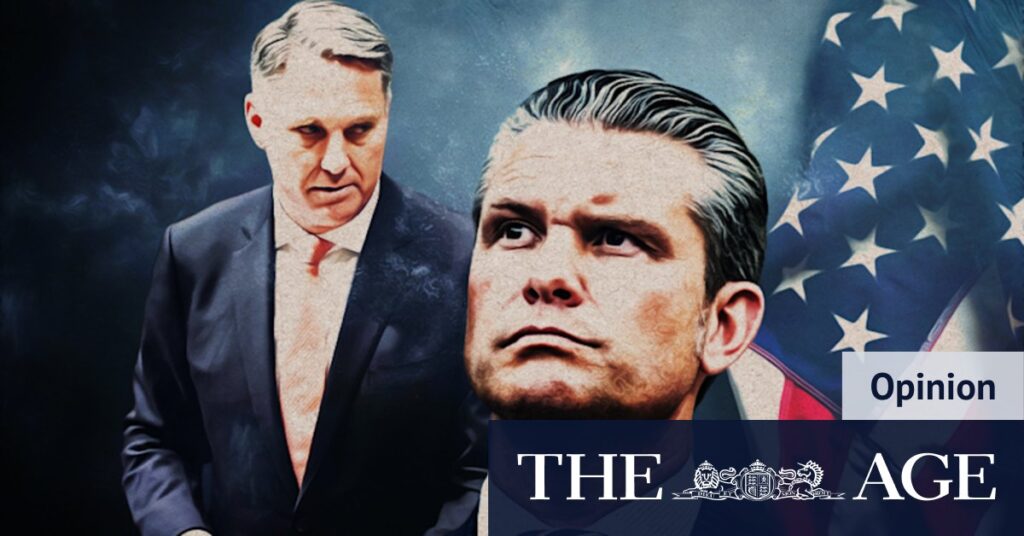
With Defence Minister Richard Marles recently returning from a discreet visit to the United States, the longstanding alliance between Australia and the US is once again under scrutiny. This renewed focus has been a constant since the second Trump administration, but the latest discussions have sparked debates over the nature of Marles’ interaction with US Secretary of Defence Pete Hegseth. Was it merely a coincidental photo opportunity or a strategic meeting? While this may reflect more on the internal dynamics of the Pentagon, it raises a critical question: In the event of an Indo-Pacific conflict, how would Australia and the US coordinate their military efforts, and are the expectations of each nation’s role clearly defined and aligned with Australia’s interests?
The question of Australia’s defense strategy in a potential Pacific conflict is more pressing than ever. Defence Minister Richard Marles’ meeting with US Defence Secretary Pete Hegseth underscores the importance of this alliance. However, the core issue lies in whether Australia’s role complements US power while maintaining its sovereignty and ability to act independently. This includes defending its territory, securing maritime trade routes, and supporting regional partners without over-reliance on Washington.
Australia’s Sovereign Defense Capabilities
Australia’s defense strategy has historically relied on its alliance with the United States, allowing it to exert significant influence despite its relatively small population of 27 million. Yet, as a sovereign nation, Australia must prioritize its own defense capabilities. This includes ensuring it can independently execute key roles, such as protecting its borders and maintaining regional stability.
The debate over Australia’s role has intensified with reports that Elbridge Colby, the Pentagon’s undersecretary of defense for policy, is urging Australia to clarify its position in a potential conflict over Taiwan. While there are no formal demands for a pre-commitment, the US seeks greater certainty from its ally. This desire for clarity is mutual, as Australia also benefits from understanding its responsibilities in such scenarios.
The Strategic Importance of the US-Australia Alliance
The alliance between the US and Australia has been a cornerstone of Australia’s military strategy for decades. This partnership has enabled Australia to punch above its weight in global affairs, particularly during periods of great-power competition. Despite recent tensions over the US review of the AUKUS agreement and calls for increased defense spending, cooperation between Canberra and Washington has reached unprecedented levels since World War II.
Initiatives such as enhanced force posture and expanded military exercises and exchanges highlight the deepening ties between the two nations. These efforts are crucial in ensuring both countries are prepared to respond to potential threats in the Indo-Pacific region.
Expert Opinions and Historical Context
Experts argue that Australia must strike a balance between leveraging its alliance with the US and maintaining its autonomy. Dr. John Blaxland, a professor of international security at the Australian National University, suggests that “Australia should focus on building its own capabilities while remaining a reliable partner to the US.” This sentiment echoes historical lessons from past conflicts where alliances have been both beneficial and challenging.
“Australia should focus on complementing US power while retaining the ability to execute key roles independently.” – Dr. John Blaxland
Historically, Australia’s defense policy has evolved through its experiences in World War II and subsequent conflicts, where reliance on allies was necessary but also highlighted the need for self-reliance. This historical perspective is crucial in shaping current and future defense strategies.
Looking Ahead: The Future of Australia’s Defense Strategy
The evolving geopolitical landscape in the Indo-Pacific demands that Australia reassess its defense priorities. As tensions rise over Taiwan and other regional issues, clear communication and strategic alignment with the US are essential. However, Australia must also invest in its own defense capabilities to ensure it can act independently when necessary.
The path forward involves a delicate balance of strengthening alliances while bolstering national defense. As Australia continues to navigate these complex dynamics, the focus must remain on safeguarding its sovereignty and contributing to regional stability.
In conclusion, the discussions surrounding Australia’s role in a potential Pacific conflict highlight the need for clarity and strategic foresight. By enhancing its defense capabilities and maintaining strong alliances, Australia can better position itself to face future challenges in the Indo-Pacific region.





